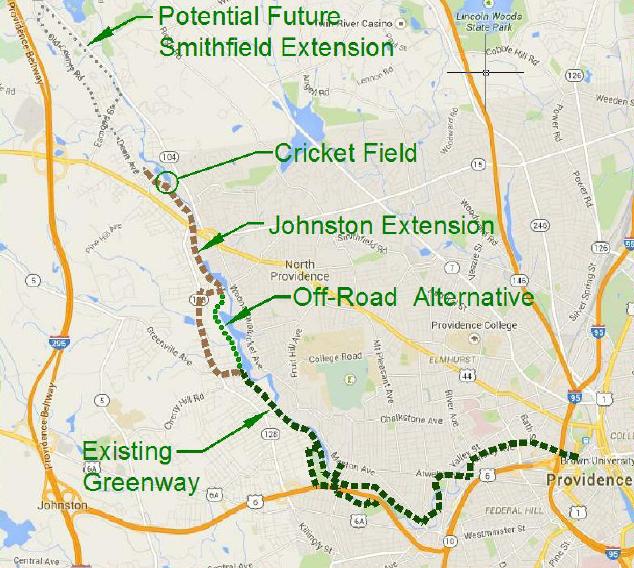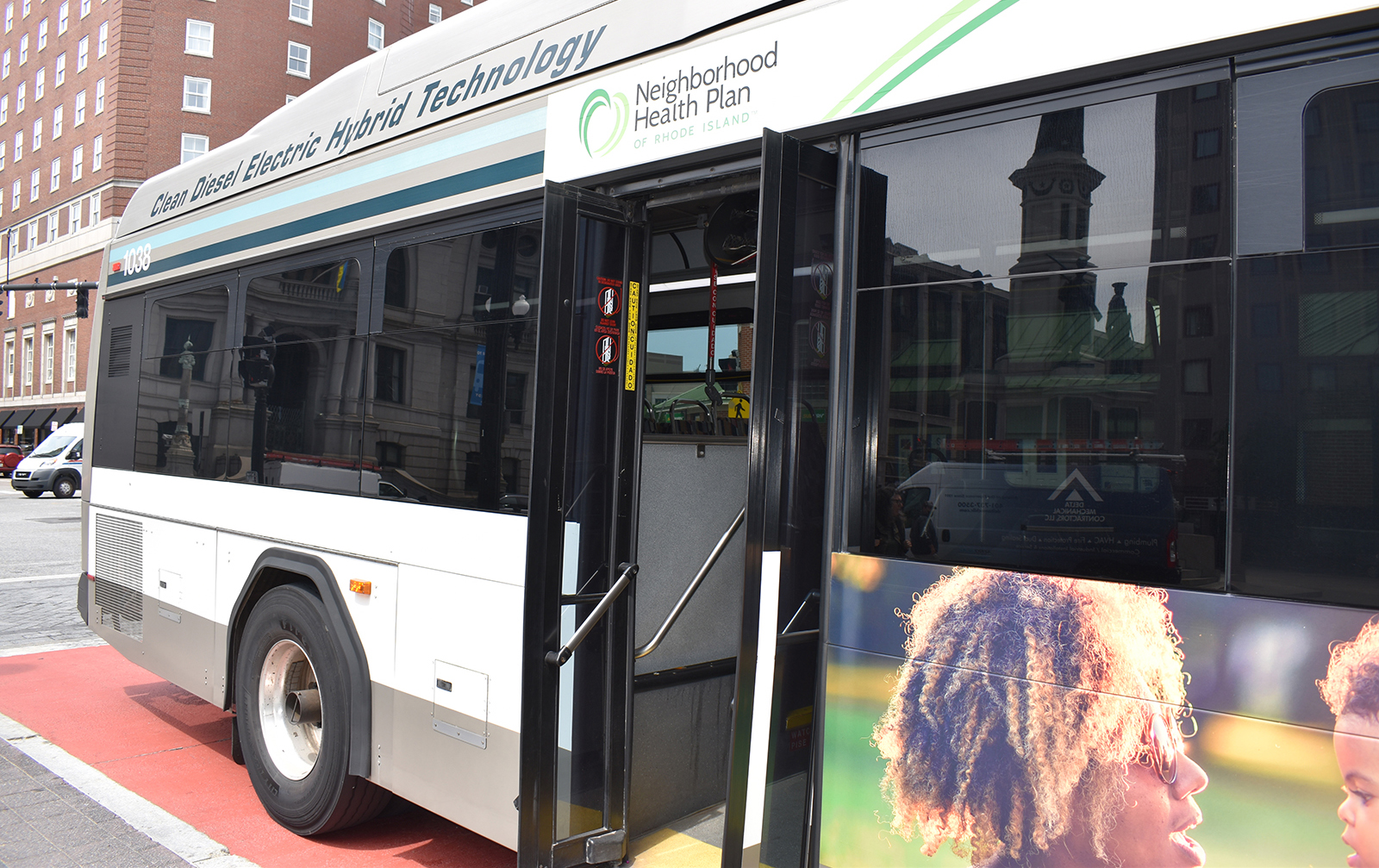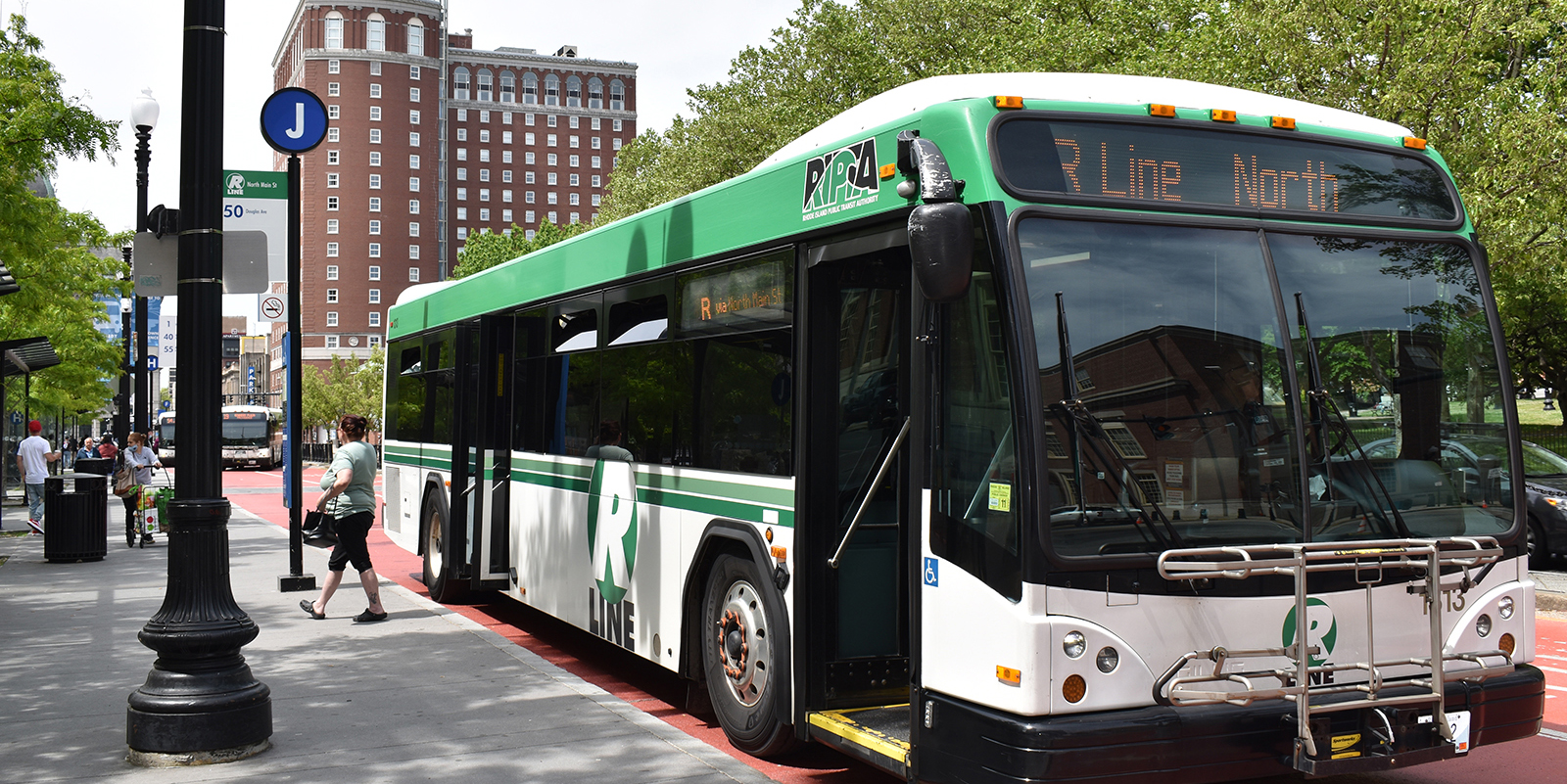Neighbors Concerned About Extending Bike Path
Police say Woonasquatucket River Greenway has helped lower crime in Providence neighborhood
November 24, 2015
JOHNSTON, R.I. — A bike path can have myriad benefits for a community, including economic, transportation, recreational, health and environmental, but living near a poorly designed access point to that bike path can be a headache. Those were the takeaways from a recent meeting about the proposal to extend the Woonasquatucket River Greenway from its current endpoint near Lymann Avenue to Cricket Field, near the Smithfield border.
The meeting, organized by the Woonasquatucket River Watershed Council (WRWC), attracted about 60 people. The Providence-based nonprofit maintains the existing segments of the Woonasquatucket River Greenway, which stretches from Providence Place mall through the Valley and Olneyville neighborhoods of Providence and into Johnston.
At the meeting, WRWC provided information about the community impacts and management practices of the existing greenway, and the next steps relating to the proposed extension. At a future date, the Town Council will be asked to vote on whether the project should proceed to the concept-design phase.
Currently, WRWC has only rough sketches of routes the greenway might follow to connect Lymann Avenue to Cricket Field. During the concept-design phase, detailed plans would be created over the course of several years, presented to the public for feedback and modified accordingly. Then, another vote would determine whether to build the extension.
WRWC, the Rhode Island Department of Transportation and the federal government would pay for the design, construction, operation and maintenance of the bike path, according to WRWC.
Most meeting attendees supported extending the bike path, but, because the meeting wasn’t widely advertised beyond WRWC’s mailing list and to residents living near the existing and proposed routes of the greenway, it’s unclear whether this is representational of the town’s views. About a dozen people representing about five households near the Lymann Avenue terminus of the existing greenway opposed its extension.
Local officials, including Mayor Joseph Polisena, Town Council president Robert Russo, Rep. Deborah Fellela, D-Johnston, and deputy police chief Daniel Parrillo attended the meeting, but noted they had no current position on the proposal.
Greenway benefits
During the past two decades, the Woonasquatucket River Greenway has benefitted the communities it travels through, according to WRWC. It has provided access to and awareness of the Woonasquatucket River — one of 14 American Heritage rivers, such as the Hudson and Rio Grande. It has revitalized parks and neighborhoods that surround it, including Donnigan, Riverside and Merino parks.

Dean Isabella, a Providence Police Department captain, said the city has witnessed a 90 percent reduction in crime in the neighborhood surrounding Aleppo Street in Olneyville after Riverside Park was built as part of the greenway project about a decade ago. Prior to the greenway’s existence, Aleppo Street was notorious for drug dealing, gang violence and prostitution, according to Isabella, who was a sergeant in the neighborhood at the time.
“Aleppo Street, for as long as I’d been a police officer, had been one of the worst crime areas in Providence,” he said. When he learned WRWC wanted to build a park and bike path in the neighborhood, he thought it was a mistake. To his surprise, the greenway spurred development of low-income housing in the neighborhood, boosted the area’s population and reduced crime, which has stayed down, he said.
“As someone who was as concerned as you are about public safety issues, I can tell you that this has been a complete asset to the city of Providence and Olneyville,” said Isabella, who credited WRWC for much of the success.
The Woonasquatucket River Greenway is maintained, in large part, by River Rangers — youth hired by WRWC to do landscaping and maintenance work. WRWC has employed 60 River Rangers over the past five years to maintain the greenway, according to WRWC.
Chris Carlone, a 2013 graduate of Johnston Senior High School and a current Community College of Rhode Island student, called his experience as a River Ranger “life-changing.”
“It was a different experience than jobs I’d had before,” Carlone said, noting the work taught him landscaping skills, teamwork, project-oriented work and networking skills.
Bike paths can have a beneficial impact on the value of surrounding homes, according to WRWC. Additionally, walking and biking amenities are a top priority among home buyers, according to Molly Henry, from the East Coast Greenway Alliance, who spoke at the meeting.
Public comment
Supporters of the proposal to enter the concept-design phase of the greenway extension project focused mostly on the recreational and health benefits bike paths offer.
Bob Goodwin, a local resident who lives in the area under consideration for the greenway’s extension, said he spends an hour and a half each week walking one of the state’s bike paths with a group of 14 people. “Everybody gets a good walk, and then, if we’re in this area, we go to Atwood Grille or someplace like that to talk about the walk,” he said.
Nelson Rocha, who started the group Johnston Residents for the Proposed Extension of Woonasquatucket Bike Path, cited connecting his daughters to nature as another reason to support extending the greenway.
The five or so households that opposed extending the bike path were each from the neighborhood near the Lymann Avenue terminus of the greenway, where the bike path abruptly ends and dumps users onto a residential, dead-end street. They said the once-quiet street has become “a thruway,” and that a lack of parking accommodations for bike-path users results in an influx of people parking on the street in front of their houses.
They also complained about crime after nightfall. They said homes and cars are regularly broken into, property, such as bicycles, are stolen, and drug dealers conduct business on the bike path using Lymann Avenue as their access point.
“It’s great that (WRWC) has the ranger program — 9 a.m. to 5 p.m. — but we live it after. We have to pay for it, we have to experience the cops down there nightly, we’re the ones being affected,” said a resident of Tyler Street.
Tyler Street residents, whose backyards abut the Woonasquatucket River, said there isn’t enough room to extend the bike path between their property and the water, a route that seems likely to be considered during the concept-design phase. Lymann Avenue residents said they oppose any on-road bike lane that includes their street; this route also seems likely to be considered.
A letter read on behalf of Ann Ducharme, a local resident whose property abuts the existing bike path, said the defunct railroad bed behind her house attracted unsavory activity even before the construction of the greenway. She cited kids hanging out, people stealing cars and abandoning them in or near the river, people riding dirt bikes and 4-wheelers, and people shooting guns.
“Since the bike path came in, most of it has stopped,” she wrote.
Ducharme did note that break-ins are still an issue, and that kids regularly cut across her property to access the bike path. She said she supports the greenway, and suggested increasing police monitoring, investing in security cameras and adding public access points as solutions to those problems.
Deputy police chief Parrillo said he will increase patrols in the area at night as a result of the meeting.




the woony bike path was a highlight of my time living in providence! I ran it every other day.
The few "problems" as noted by those living in the Lymann Ave neighborhood can be addressed and corrected. The value of extending this path is obvious and the numerous benefits of a community bicycle / recreation path are well documented both in RI and throughout the country. The real puzzler is this: "During the concept-design phase, detailed plans would be created over the course of several years, presented to the public for feedback and modified accordingly." SEVERAL YEARS? That sounds beyond ridiculous.
As a resident of Graniteville, who often uses the bikepath with my kids – woukld like to see it extended, not only for ease of access from where we live, but also to be able to avoid those people on Lyman Avenue that we are forced to see (and get stared at by) everytime we want to use the bikepath. Unfortunately, due to the fact my kids are far too young to drive Geo Waterman road on their bikes, whenever we want to use the path, we have to get dropped off at the Lyman ave terminus(hence the stare down)..So here’s a thought – extend the bike path, and those Lyamn Avenue residents who so much don’t want to see us, will never have to see us again, and make the bikeriding for my kids (as well as the others here in Graniteville) ease of access. Oh, and as far as their argument about the illegal activity going on at night on the bikepath…That activity was going on long before the bikepaths existence. I think the real "fear" is that they are afraid that people from "the other side of the tracks" are going to come into "their" town. Well, I think what’s not being said says a whole lot, and its shameful. …So in closing, to those of you that like to stare me down whenever I take the kids by your house to go on the bikepath – if it doesn’t get extended – stare away, because YOU are leaving us no choice.
So sad that this never happened. There’s already a sketchy footpath along the river. This proposal would clean it up, maintain it, and invite families to use it: residents concerned about crime should see this as an improvement over what’s there right now.